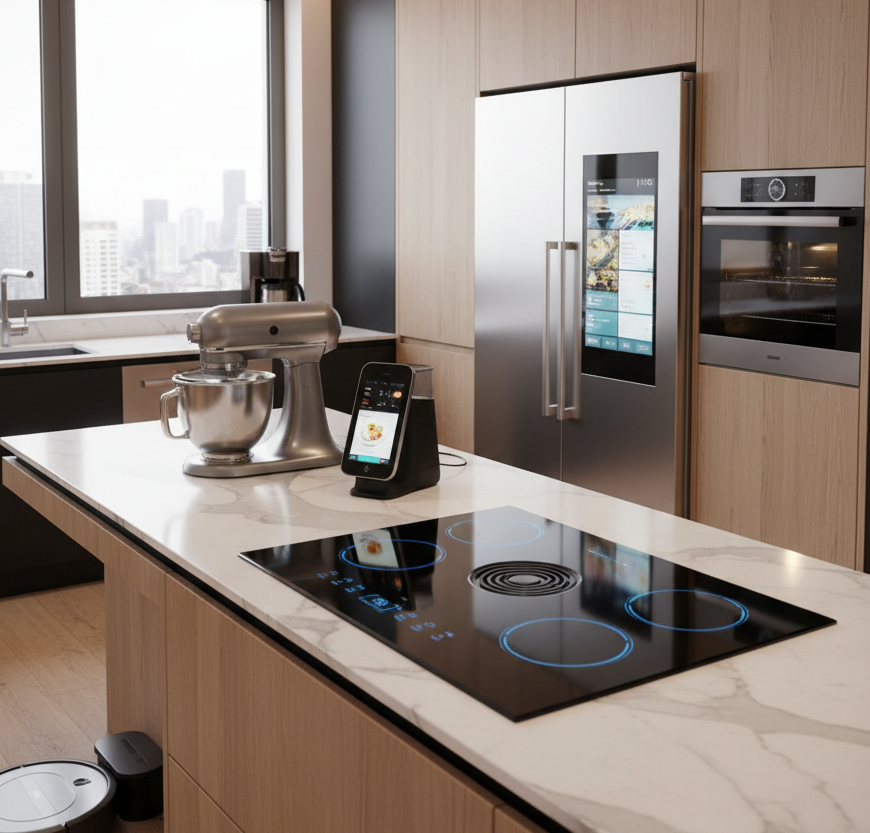In the modern household, home and kitchen appliances are no longer mere luxuries but essential components that simplify daily life, enhance efficiency, and even elevate comfort. From the humble toaster to sophisticated smart refrigerators, these devices are integral to how we live, cook, and maintain our homes. The market for home and kitchen appliances is a dynamic and ever-evolving landscape, driven by technological innovation, shifting consumer preferences, and a constant quest for convenience and sustainability. This article delves into the intricacies of appliance sales and transactions, exploring the factors that influence purchasing decisions, the different sales channels, the impact of technology, and key trends shaping the industry.
Understanding the Appliance Market: A Snapshot
The home and kitchen appliance market is vast and segmented. It can be broadly categorized into:
- Major Appliances (White Goods): These are large household appliances used for routine tasks such as cooking, food preservation, laundry, and climate control. Examples include refrigerators, freezers, ovens, stoves, dishwashers, washing machines, dryers, air conditioners, and water heaters. Their purchase often involves significant investment and a longer decision-making process.
- Small Appliances (Brown Goods/Small Electrics): These are portable or semi-portable machines typically used on kitchen countertops or other designated areas. Examples include blenders, toasters, coffee makers, microwaves, food processors, vacuum cleaners, and irons. These purchases are often more frequent and driven by specific needs or upgrades.
- Smart Appliances: A growing segment that integrates internet connectivity and smart technology, allowing for remote control, automation, and enhanced functionality. Examples include smart refrigerators that manage inventory, smart ovens with pre-programmed recipes, and smart washing machines that optimize cycles.
The market size is substantial and continues to grow globally. Factors like urbanization, increasing disposable income, rising living standards, and the growing demand for smart home solutions are key drivers of this expansion.
The Consumer Journey: From Need to Purchase
The process of buying a home or kitchen appliance is often a multi-stage journey influenced by various factors:
- Need Recognition: This is the initial trigger. It could be due to an old appliance breaking down, a desire for an upgrade, a move to a new home, or simply identifying a need for a new functionality (e.g., a stand mixer for baking enthusiasts).
- Information Search: Consumers typically engage in extensive research. This involves:
- Online Research: Reading product reviews, comparing specifications on e-commerce sites, watching video demonstrations, and seeking recommendations on forums and social media. Google search plays a pivotal role here, with consumers actively looking for “best refrigerators 2023,” “dishwasher reviews,” or “energy-efficient washing machines.”
- In-Store Visits: Physically inspecting appliances, assessing size, aesthetics, and understanding features from sales associates.
- Word-of-Mouth: Seeking advice from friends, family, and trusted acquaintances.
- Evaluation of Alternatives: Consumers compare different brands, models, features, prices, and warranties. Key considerations include:
- Price: Budget constraints are almost always a factor.
- Features & Functionality: Specific requirements like ice makers, convection settings, smart capabilities, or specific capacity.
- Brand Reputation & Reliability: Trust in established brands and their track record for durability and customer service.
- Energy Efficiency: A significant concern for many, looking for ENERGY STAR ratings to save on utility bills.
- Aesthetics & Design: How well the appliance fits into the home’s decor.
- Warranty & After-Sales Service: The assurance of support in case of issues.
- Purchase Decision: The culmination of the research and evaluation phase, leading to the selection of a specific appliance.
- Post-Purchase Evaluation: After the purchase and installation, consumers assess their satisfaction. This experience can lead to positive or negative reviews, influencing future purchases by themselves and others.
Sales Channels: Where Appliances are Sold
The distribution of home and kitchen appliances spans multiple channels, each with its unique advantages:
- Brick-and-Mortar Retailers:
- Big-Box Stores: Large retail chains like Best Buy, Lowe’s, and Home Depot in the US, or similar chains globally, offer a wide selection, competitive pricing, and often installation services. They allow consumers to see and touch products.
- Independent Appliance Stores: Smaller, specialized stores often provide more personalized service, expert advice, and sometimes unique or high-end brands. They often excel in local customer relationships.
- Department Stores: Some department stores also carry a range of small and major appliances, especially higher-end models.
- Online Retailers (E-commerce):
- Brand Websites: Manufacturers often sell directly to consumers through their own e-commerce platforms. This offers direct engagement and sometimes exclusive deals.
- Marketplaces: Giants like Amazon, eBay, and regional equivalents host a vast array of appliances from various brands, offering convenience, competitive pricing, and extensive review systems.
- Specialized Online Retailers: Websites focusing solely on appliances can offer deep product knowledge and niche selections. The convenience of 24/7 shopping, home delivery, and easy price comparison has driven significant growth in online appliance sales, particularly for small appliances and increasingly for major appliances.
- Wholesale & Business-to-Business (B2B):
- Contract Sales: Suppliers selling appliances in bulk to real estate developers for new constructions, hospitality businesses for hotels, or property management companies for rental units.
- Distributors: Intermediaries who purchase from manufacturers and sell to retailers or other businesses.
The Impact of Technology on Sales & Transactions
Technology has revolutionized both the appliances themselves and the way they are sold and purchased.
- Smart Appliances & IoT (Internet of Things): The integration of smart technology is a game-changer. These appliances offer features like remote control via smartphone apps, predictive maintenance alerts, energy usage monitoring, and seamless integration with smart home ecosystems. This creates new selling points and opportunities for upselling.
- Augmented Reality (AR): Some retailers and brands use AR tools that allow customers to virtually place an appliance in their home using their smartphone camera, helping them visualize how it would look and fit before making a purchase.
- Personalized Shopping Experiences: E-commerce platforms leverage data analytics to offer personalized product recommendations, discounts, and content based on browsing history and past purchases.
- Digital Payment & Financing: The ease of online payment, installment plans, and various financing options (e.g., “buy now, pay later” services) have made appliance purchases more accessible.
- Logistics & Supply Chain Management: Technology optimizes inventory management, warehousing, and last-mile delivery, especially crucial for large, bulky appliances. GPS tracking and scheduling tools provide greater transparency for customers awaiting delivery.
- Customer Service & Support: AI-powered chatbots, extensive online FAQs, and virtual assistants provide immediate support and troubleshooting, enhancing the post-purchase experience.
Key Trends Shaping the Appliance Industry
Several major trends are influencing appliance sales and transactions globally:
- Sustainability & Energy Efficiency: Consumers are increasingly conscious of their environmental footprint and utility costs. Appliances with high energy efficiency ratings (e.g., ENERGY STAR) are highly sought after. Manufacturers are responding by developing more eco-friendly products and promoting their sustainable practices.
- Smart Home Integration: The desire for a fully connected home drives demand for smart appliances that can communicate with each other and be controlled from a central hub or smartphone. This trend is pushing manufacturers to develop compatible ecosystems.
- Health & Wellness Focus: Appliances that contribute to a healthier lifestyle are gaining traction. This includes air purifiers, juicers, sophisticated water filters, and steam ovens that preserve nutrients.
- Premiumization & Customization: There’s a growing market for high-end, designer appliances that offer superior performance, unique features, and aesthetic appeal. Customization options, such as panel-ready refrigerators that blend with cabinetry, are also becoming popular.
- E-commerce Dominance (Especially for Small Appliances): While major appliances still see significant in-store purchases, the convenience and competitive pricing of online platforms continue to drive e-commerce growth across the board. The challenge for major appliance retailers online is to replicate the in-store experience and provide robust delivery and installation services.
- Subscription Models & Servitization: Emerging models where consumers might subscribe to appliance usage rather than outright purchase, or pay for enhanced service packages, are being explored, though still nascent in the broader market.
- Circular Economy Initiatives: Brands are focusing on designing appliances that are easier to repair, have longer lifespans, and are recyclable at the end of their utility, moving away from a linear “take-make-dispose” model.
Navigating the Competitive Landscape
The appliance market is highly competitive, with established global giants alongside innovative newcomers. To succeed, businesses in this sector must focus on:
- Product Innovation: Continuously developing new features, improving energy efficiency, and integrating smart technology.
- Brand Building: Establishing a strong brand identity, reputation for quality, and excellent customer service.
- Multi-Channel Strategy: Offering a seamless customer experience across online and offline channels.
- Effective Marketing & SEO: Ensuring products are easily discoverable through search engines (e.g., optimizing for keywords like “best smart oven,” “quietest dishwasher,” “refrigerator deals”).
- Customer Experience: Providing exceptional pre-sales advice, smooth transaction processes, reliable delivery and installation, and responsive after-sales support.
- Competitive Pricing & Promotions: Offering value through competitive pricing, bundles, and seasonal promotions.
The Future of Appliance Sales
The future modern household of home and kitchen appliance sales will likely be characterized by even greater intelligence, connectivity, and sustainability. As AI and machine learning become more sophisticated, appliances will anticipate needs, optimize performance autonomously, and integrate even more seamlessly into our lives. The focus on energy efficiency and responsible consumption will only intensify, pushing manufacturers towards truly circular product lifecycles. For consumers, the purchasing journey will become more personalized and convenient, driven by advanced digital tools and a diverse range of buying options. The businesses that embrace these technological and societal shifts will be the ones that thrive in this essential and exciting market.







